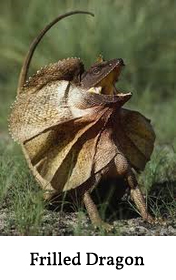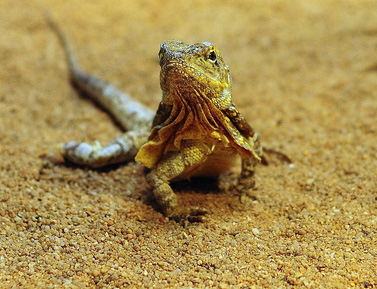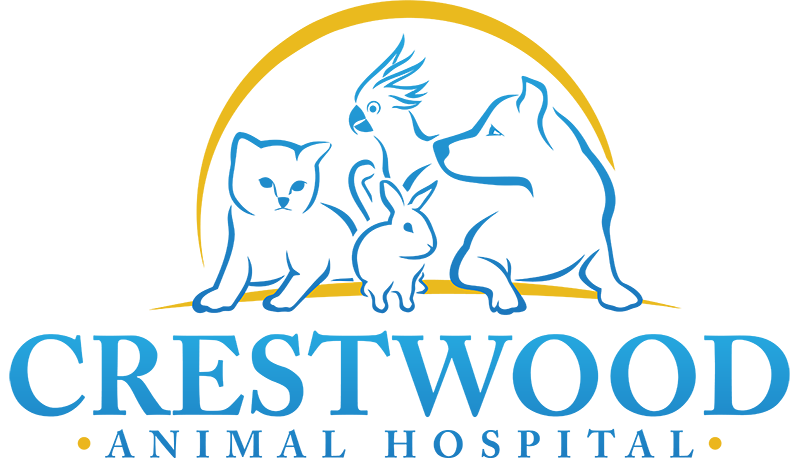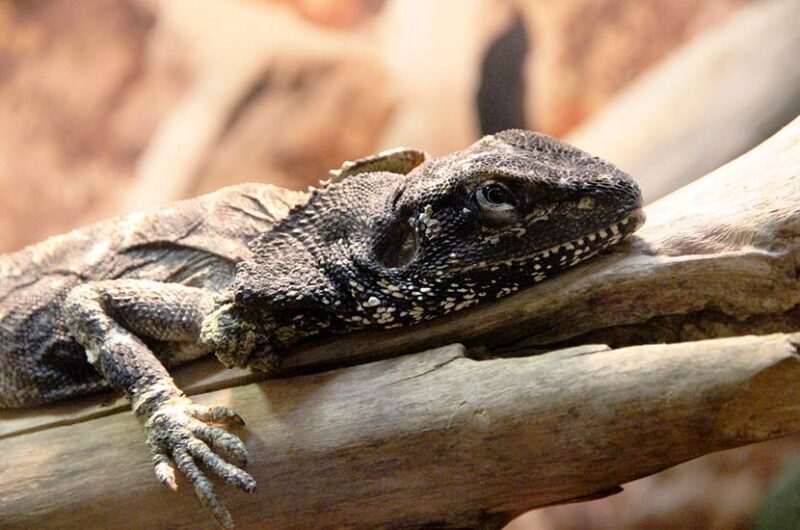Erica Mede, CVT
Natural History
 Frilled dragons are a grayish colored lizard from the savanna woodland areas, and occasionally the tropical and temperate forests of Australia and New Guinea. The ones from the Australian blood line are larger but the New Guinea descendants are much more common. The Australians will have distinct white cheeks. While the New Guinea variety reach 18-24 inches, Australian dragons can grow up to 3 feet! With a longevity of 12-15 years these Frill-necked lizards, or Frilled lizards as some call them, are becoming increasingly popular. The iconic frill around the neck normally lies folded against the head and neck. When fully extended, the long spines of cartilage connected to the jaw bone are used as an impressive threat display.
Frilled dragons are a grayish colored lizard from the savanna woodland areas, and occasionally the tropical and temperate forests of Australia and New Guinea. The ones from the Australian blood line are larger but the New Guinea descendants are much more common. The Australians will have distinct white cheeks. While the New Guinea variety reach 18-24 inches, Australian dragons can grow up to 3 feet! With a longevity of 12-15 years these Frill-necked lizards, or Frilled lizards as some call them, are becoming increasingly popular. The iconic frill around the neck normally lies folded against the head and neck. When fully extended, the long spines of cartilage connected to the jaw bone are used as an impressive threat display.
Enclosure
Hatchlings and juveniles grow fast but can be maintained in a 20 to 55 gallon aquarium. Adults can be housed in aquariums as large as 75 or 120 gallons! The smallest cage for a singly housed adult is a 40 gallon breeder although larger is preferred and often required. Custom enclosures for adults made of wood or melamine should be 4 feet high, 3 feet long, and 2 feet deep to accommodate these arboreal lizards according to some sources. Ventilation is important regardless of the size of the enclosure. It is recommended that aquariums have 3 sides covered to prevent escape attempts and allow for a feeling of security.
During the warmer months, Frilled lizards can be housed outside in an outdoor set-up created with wood and wire mesh. There are several blue print plans available on the internet for these enclosures. Please, do not take the aquarium outside! This can cause lethal hyperthermia especially in direct sun light. Frequent supervision is required! These enclosures must be protected from large amounts of rainfall and predators. The optimal positioning allows for some shade to be available as well.
Substrate
It is never recommended to keep Frilled dragons on a sand substrate even the calcium sand sold in pet stores. Life threatening impactions are frequently caused by accidental ingestion of particulate bedding including sand, coconut fiber substrate, and crushed walnut bedding. A better substrate that is easier to clean is indoor/outdoor carpet, potting soil (requires weekly changing), and butcher paper. The substrate should be spot cleaned daily and changed as needed or after 7 days, whichever comes first.
Temperature
 The temperature for these dragons during the day should be around 84-90 °F and drops to 72°F at night. The basking site should be around 95-100°F. Two thermometers should be used in the cage. One placed at the level of the basking site and the other on the cool end of the tank an inch above the substrate. It is highly recommended to regulate the temperature using a thermostat. The primary heat source should be an overhead basking light or ceramic heat emitter. Secondary heat if needed ideally comes from under tank heaters under half the tank. Do not use electrical heating rocks due to the extremely likely chance the bearded dragon will develop thermal burns.
The temperature for these dragons during the day should be around 84-90 °F and drops to 72°F at night. The basking site should be around 95-100°F. Two thermometers should be used in the cage. One placed at the level of the basking site and the other on the cool end of the tank an inch above the substrate. It is highly recommended to regulate the temperature using a thermostat. The primary heat source should be an overhead basking light or ceramic heat emitter. Secondary heat if needed ideally comes from under tank heaters under half the tank. Do not use electrical heating rocks due to the extremely likely chance the bearded dragon will develop thermal burns.
Humidity
The humidity in the cage should be maintained between 55 and 65%. This can be achieved by placing a water dish in the enclosure, preferably one the lizard can soak in, and daily misting. A hygrometer is highly recommended.
Lighting
UVB lights are necessary for the proper growth and maintenance of bearded dragons. The ultraviolet B radiation stimulates the synthesis of calcium. The best source of UVB is the sun but only when the animal is outside and directly in the sun light. Never place the cage by a window. The UVB light is filtered out through glass and the chance of over-heating the enclosure is extremely high. The recommended bulb for a hatchling and sub-adult is a Repti Sun 10.0 and a Repti Sun 5.0 for adults. The bulb must be changed yearly as the strength of the UVB will deteriorate with time despite the bulb giving off visible light. Placement of the bulb should be overhead and no more than 10 inches away from the basking site. The light cycle for Frilled dragons should be 14 hours of light with 10 hours of darkness.
Cage Accessories
Dried wood branches are appreciated as this species is an avid climber. A large rock under the basking light makes a wonderful basking site. Live plants such as aloe and palms can be added to the enclosure. Artificial plants are easily disinfected and make appropriate accessories. Most lizards will utilize a half log hiding area. Custom and creative hides can be made as well.
Feeding
Adult dragons are insectivores with some omnivorous habits while hatchlings and juveniles are nearly fully insectivorous. Hatchlings up to two months old should be fed two to three times a day a mixture of insects and healthy greens. Proper growth is achieved through several small meals with smaller prey items versus one large meal with a large prey item. Adults, however, can be fed a salad of greens such as romaine lettuce, escarole, Swiss chard, mustard greens, and turnip greens with a small amount of other vegetables and fruits such as carrots, peas, strawberries, blueberries, melon, and squash once a day. Edible flowers such as squash blossoms are also okay to offer and generally relished. Insects such as crickets, meal worms, horn worms, silk worms, small pinkies (once or twice a month), and feeder roaches (such as dubias) are excellent protein sources and should be offered every other day to every three days depending on the lizards’ body condition (thin, normal, or obese).
Gut loading feeder insects with healthy calcium rich greens such as kale and Swiss chard is required for a positive calcium to phosphorous ratio (this prevents and corrects metabolic bone disease). Feeder insects must be dusted with a calcium supplement (one without phosphorous) 3-4 times a week and a multi-vitamin once a week. Some owners feed small pinkie mice to their larger adults. It is recommended to limit the pinkie feedings to an occasional treat or once every two week feeding due to the higher fat content. The most important rule to remember when it comes to insect and rodent prey is that the feeder cannot be longer than the distance between the dragon’s eyes! This helps prevent dangerous impaction and digestion issues including choking.
If you have any questions, please feel free to call us at (502) 241-4117.

